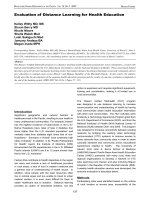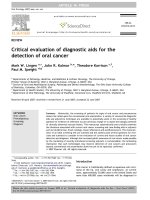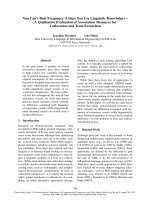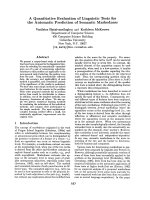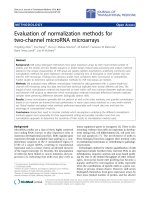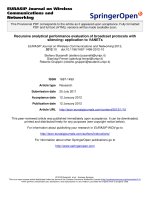Performance evaluation of diamond tools for micro grooving
Bạn đang xem bản rút gọn của tài liệu. Xem và tải ngay bản đầy đủ của tài liệu tại đây (6.54 MB, 102 trang )
PERFORMANCE EVALUATION OF DIAMOND
TOOLS FOR MICRO-GROOVING
ANGSHUMAN GHOSH
(B.Sc. Engg.(Mech.), BUET)
A THESIS SUBMITTED
FOR THE DEGREE OF MASTER OF ENGINEERING
DEPARTMENT OF MECHANICAL ENGINEERING
NATIONAL UNIVERSITY OF SINGAPORE
2007
Acknowledgements
The author would like to express his deepest and heartfelt gratitude and appreciation to
his supervisor Professor Mustafizur Rahman, Department of Mechanical Engineering,
National University of Singapore (NUS), for his valuable guidance, continuous support
and encouragement throughout the entire research work. It has been an honor for the
author to work with Professor Rahman.
The author is greatly indebted to Mr. Neo Ken Soon, Professional Officer, Advanced
Manufacturing Laboratory (AML), for his valuable suggestions and technical support.
The author would also like to show his appreciation to Mr. Tan Choon Huat, Senior
Laboratory Officer-In-Charge and Mr. Yeo Eng Huat (Nelson), Laboratory Officer,
Advanced Manufacturing Laboratory (AML) for their technical assistance and support
in performing the experimental works in the study. In this instance the author would
like to appreciate Mr. Jamilon Bin Sukami, Final Year Project Student for sharing his
time slot for the experiments.
At various stages of this research work, a lot of encouraging supports and help have
come from the author’s friends and colleagues which are heartily acknowledged with
cordial thanks. Among them the author would like to specially thank Mr. K. V. R.
Subrahmanyam, Mr. Woon Keng Soon, Mr. Shubhra Jyoti Bhadra, Mr. Md. Mazharul
Haque, Mr. Ashim Kumar Debnath, Mr. Mohammad Ahsan Habib and Mr.
Mohammad Majharul Islam.
Performance Evaluation of Diamond Tools for Micro-Grooving
i
Acknowledgements
The author would like to acknowledge the immense love and blessings, continuous
inspiration and mental support throughout his life from his father – Mr. Arun Kiran
Ghosh, mother – Mrs. Kalpona Ghosh and sister – Mrs. Modhumita Ghosh.
Finally the author would like to take this opportunity to show his sincere thank to
National University of Singapore for the financial support and also for providing such
a high-end research facility without which it would not be possible to conduct this
research work.
Performance Evaluation of Diamond Tools for Micro-Grooving
ii
Table of Contents
Acknowledgements ........................................................................................................ i
Table of Contents .........................................................................................................iii
Summary...................................................................................................................... vii
List of Tables ................................................................................................................ ix
List of Figures................................................................................................................ x
List of Symbols ........................................................................................................... xiv
Chapter One: Introduction .......................................................................................... 1
1.1 Overview & Motivation...................................................................................... 1
1.2 Objectives ........................................................................................................... 3
1.3 Organization of Thesis........................................................................................ 3
Chapter Two: Literature Review ................................................................................ 4
2.1 Introduction......................................................................................................... 4
2.2 Properties of Electroless Nickel Plating ............................................................. 5
2.2.1 Structure....................................................................................................... 5
2.2.2 Mechanical Properties.................................................................................. 6
2.2.3 Hardness....................................................................................................... 7
2.2.4 Wear Resistance........................................................................................... 7
2.2.5 Corrosion Resistance ................................................................................... 8
2.3 Machining of Electroless Nickel......................................................................... 9
2.3.1 Machining with Diamond Tools ................................................................ 10
2.3.2 Diamond Tool Wear .................................................................................. 12
Performance Evaluation of Diamond Tools for Micro-Grooving
Table of Contents
2.3.3 Scope for Further Work ............................................................................. 14
2.4 Conclusions....................................................................................................... 14
Chapter Three: Theoretical Aspects ......................................................................... 16
3.1 Introduction....................................................................................................... 16
3.2 Chip Formation ................................................................................................. 16
3.3 Tool Geometry and Minimum Cutting Thickness ............................................ 17
3.4 Cutting Force .................................................................................................... 22
3.5 Cutting Temperature ......................................................................................... 22
3.6 Cutting Fluid ..................................................................................................... 22
3.7 Conclusions....................................................................................................... 23
Chapter Four: Experimental Details ........................................................................ 24
4.1 Introduction....................................................................................................... 24
4.2 Experimental Set-up.......................................................................................... 24
4.2.1 Toshiba Ultra-Precision Machine .............................................................. 26
4.2.2 Diamond Tools........................................................................................... 26
4.2.3 Workpiece .................................................................................................. 28
4.2.4 Force Data Acquisition System ................................................................. 30
4.2.5 Chip Removal System................................................................................ 30
4.2.6 Lubrication System .................................................................................... 30
4.3 Measuring Equipments Used ............................................................................ 31
4.3.1 Nomarski Optical Microscope ................................................................... 31
4.3.2 Keyence VHX Digital Microscope............................................................ 31
4.3.3 JEOL JSM-5500 Scanning Electron Microscope ...................................... 32
Performance Evaluation of Diamond Tools for Micro-Grooving
iv
Table of Contents
4.4 Experimental Procedure.................................................................................... 33
4.4.1 Effect of Infeed Rate on Tool Life............................................................. 35
4.4.2 Effect of Cutting Speed on Tool Life ........................................................ 36
4.4.3 Effect of Lubricant Material on Tool Life ................................................. 37
4.4.4 Effect of Tool Point Angle on Tool Life ................................................... 37
4.4.5 Tool Wear Observation.............................................................................. 38
4.4.6 Machined Surface Observation.................................................................. 38
4.4.7 Chips Observation...................................................................................... 39
4.5 Measurement and Data Analysis ...................................................................... 39
4.5.1 Cutting Distance and Cutting Speed Measurement ................................... 39
4.5.2 Measurement of Tool Wear ....................................................................... 40
4.5.3 Measurement of Micro-Cutting Force ....................................................... 40
4.6 Conclusions....................................................................................................... 41
Chapter Five: Results and Discussions ..................................................................... 42
5.1 Introduction....................................................................................................... 42
5.2 Summary of the Experimental Results ............................................................. 43
5.2.1 Experiment Time ....................................................................................... 43
5.2.2 Fresh Tool Observation.............................................................................. 45
5.3 Effects of Cutting Parameters on Tool Life ...................................................... 49
5.3.1 Effect of Infeed Rate on Tool Life............................................................. 49
5.3.1.1 Effect of Infeed Rate on Tool Nose Wear .......................................... 52
5.3.1.2 Effect of Infeed Rate on Cutting Force............................................... 54
5.3.2 Effect of Cutting Speed on Tool Life ........................................................ 57
5.3.2.1 Effect of Cutting Speed on Tool Nose Wear ...................................... 59
Performance Evaluation of Diamond Tools for Micro-Grooving
v
Table of Contents
5.3.2.2 Effect of Cutting Speed on Cutting Force........................................... 60
5.3.3 Effect of Lubricant Material on Tool Life ................................................. 63
5.3.3.1 Effect of Lubricant Material on Tool Nose Wear ............................... 65
5.4 Performance Comparison between 450 and 600 Tools...................................... 67
5.5 Flank Wear........................................................................................................ 69
5.6 Machined Surface Observation......................................................................... 74
5.7 Chips Observation............................................................................................. 76
5.8 Conclusions....................................................................................................... 79
Chapter Six: Conclusions and Recommendations ................................................... 80
6.1 Introduction....................................................................................................... 80
6.2 Conclusions....................................................................................................... 80
6.3 Recommendations............................................................................................. 82
Bibliography ................................................................................................................ 83
List of Publication ....................................................................................................... 87
Performance Evaluation of Diamond Tools for Micro-Grooving
vi
Summary
Electroless-nickel which exhibits excellent properties such as hardness, corrosion
resistance and wear resistance is generally used for molding dies of optical parts such
as LCD. Diamond turning is commonly used to machine such dies to achieve high
degree of surface finish and dimensional accuracy. However, the tool life in such
machining is quite short, especially so in the machining of V-shape micro grooves.
Tool wear in such application is a very important factor as small tool wear can lead to
significant degradation of groove shape and hence reduce the service quality of the end
products. While there have been some studies carried out for micro-grooving, no
significant study has so far been carried out for very narrow angle grooves on
cylindrical surface.
In this study, performance of single crystal diamond tools with tool point angles of 450
and 600 are evaluated. The wear criterion is set at 1.0µm nose wear for the cutting of
5.0μm deep V-grooves. In order to evaluate cutting performances, cutting parameters
such as infeed rate, cutting speed and lubricant material were varied. In the early stage
of the machining several chipped-off areas were observed at a distance from the
cutting zone and they remained unchanged for rest of the experiment. However the
microscopic observations of the tools during the experiments reveal that micro-grooves
started forming and enlarging at the cutting zone on the flank faces with increasing
cutting distance and eventually causing the tools to fail. Moreover chippings from the
flank edge were observed during the machining. It was found experimentally that the
450 tools experienced catastrophic failure at the tool nose in the most cases whereas the
600 tools failed only once catastrophically. It was observed that the tools wore
Performance Evaluation of Diamond Tools for Micro-Grooving
vii
Summary
gradually with cutting distance until they failed. From the experimental results, it is
found that the 600 tools performed better than the 450 tools in terms of tool life based
on complete groove cutting distance, the exception was when vegetable oil lubricant
was used. In that case the 450 tool achieved higher tool life than the 600 tool. In
addition the chips observations are the evidence of continuity of the chips and hence
ensure the ductile mode cutting.
From the experimental results, it has been found that single crystal diamond tools can
achieve the longest tool life based on complete groove cutting distance with cutting
speed of 19.2m/min cutting speed and infeed rate of 2.0μm/rev. However no
conclusive result has been found for selecting the lubricant material. It has also been
observed that the 600 tool can perform better than the 450 tool in machining V-shape
microgrooves.
Performance Evaluation of Diamond Tools for Micro-Grooving
viii
List of Tables
Table-2.1: Physical and Mechanical Properties of Electroless Nickel-Phosphorus ....... 6
Table-2.2: Taber Abraser Index for Wear Resistance of Electroless Nickel Plating...... 8
Table-4.1: Tool Configuration ...................................................................................... 27
Table-4.2: Cutting Parameter Matrix for Investigation of the Effect of Infeed Rate on
Tool Life ....................................................................................................................... 36
Table-4.3: Cutting Parameter Matrix for Investigation of the Effect of Cutting Speed
on Tool Life .................................................................................................................. 36
Table-4.4: Cutting Parameter Matrix for Investigation of the Effect of Lubricant
Material on Tool Life.................................................................................................... 37
Table-4.5: Cutting Parameter Matrix for Investigation of the Effect of Tool Point
Angle on Tool Life........................................................................................................ 38
Table-5.1: Summary of the Experimental Results........................................................ 44
Performance Evaluation of Diamond Tools for Micro-Grooving
ix
List of Figures
Figure-3.1: Schematic of chip formation ...................................................................... 17
Figure-3.2: A model of material behavior in diamond micro cutting........................... 18
Figure-3.3: Differential cutting force in elastic region ................................................ 18
Figure-3.4: Force model in cutting region .................................................................... 19
Figure-3.5: Stress on the stagnation point .................................................................... 20
Figure-4.1: Experimental Set-up................................................................................... 25
Figure-4.2: Toshiba Ultra-Precision Machine .............................................................. 26
Figure-4.3: Single Crystal Diamond Tool .................................................................... 27
Figure-4.4: Electroless Nickel Plated Workpiece, hollow end (4.4a), solid end (4.4b) 28
Figure-4.5: Schematic drawing of the machined workpiece ........................................ 29
Figure-4.6(a): Schematic drawing of the 450 grooves (all dimensions in µm)............. 29
Figure-4.6(b): Schematic drawing of the 600 grooves (all dimensions in µm)............. 30
Figure-4.7: Nomarski Optical Microscope (OLYMPUS STM-6)................................ 31
Figure-4.8: Keyence VHX Digital Microscope ............................................................ 32
Figure-4.9: JEOL JSM-5500 Scanning Electron Microscope ...................................... 33
Figure-4.10: Schematic of Tool and Workpiece showing Cutting Force (Fc) and Thrust
Force (Ft)....................................................................................................................... 40
Figure-5.1: Microscopic views of the rake face of a fresh 450 tool (tool-5); 5.1(a) –
Nomarski image and 5.1(b) – Keyence image.............................................................. 45
Figure-5.2: Microscopic views of the left flank face of a fresh 450 tool (tool-5); 5.2(a)
– Nomarski image and 5.2(b) – Keyence image........................................................... 46
Figure-5.3: Microscopic views of the right flank face of a fresh 450 tool (tool-5); 5.3(a)
– Nomarski image and 5.3(b) – Keyence image........................................................... 46
Figure-5.4: Microscopic views of the rake face of a fresh 600 tool (tool-8); 5.4(a) –
Nomarski image and 5.4(b) – Keyence image.............................................................. 47
Performance Evaluation of Diamond Tools for Micro-Grooving
x
List of Figures
Figure-5.5: Microscopic views of the left flank face of a fresh 600 tool (tool-8); 5.5(a)
– Nomarski image and 5.5(b) – Keyence image........................................................... 48
Figure-5.6: Microscopic views of the right flank face of a fresh 600 tool (tool-8); 5.6(a)
– Nomarski image and 5.6(b) – Keyence image........................................................... 48
Figure-5.7(a): Effect of Infeed Rate on Tool Wear Progression for 450 Tools ............ 50
Figure-5.7(b): Effect of Infeed Rate on Tool Wear Progression for 600 Tools ............ 50
Figure-5.8(a): Effect of Infeed Rate on Tool Life for 450 Tools .................................. 51
Figure-5.8(b): Effect of Infeed Rate on Tool Life for 600 Tools .................................. 51
Figure-5.9: Catastrophic failure of tool nose for a 450 tool (tool-3, rake face); 5.9aNomarski image and 5.9b- Keyence image .................................................................. 53
Figure-5.10: SEM image of catastrophic failure of a 450 tool (tool-3)......................... 53
Figure-5.11: Gradual progression of tool wear for a 600 tool (tool-14, rake face); 5.11aNomarski image and 5.11b- Keyence image ................................................................ 54
Figure-5.12(a): Effect of Infeed Rate on Cutting Force (Fc) for 450 Tools .................. 54
Figure-5.12(b): Effect of Infeed Rate on Cutting Force (Fc) for 600 Tools ................ 554
Figure-5.13(a): Effect of Infeed Rate on Thrust Force (Ft) for 450 Tools .................... 55
Figure-5.13(b): Effect of Infeed Rate on Thrust Force (Ft) for 600 Tools .................... 55
Figure-5.14(a): Effect of Infeed Rate on Fc/Ft for 450 Tools ........................................ 56
Figure-5.14(b): Effect of Infeed Rate on Fc/Ft for 600 Tools........................................ 56
Figure-5.15(a): Effect of Cutting Speed on Tool Wear Progression for 450 Tools ...... 57
Figure-5.15(b): Effect of Cutting Speed on Tool Wear Progression for 600 Tools ...... 57
Figure-5.16(a): Effect of Cutting Speed on Tool Life for 450 Tools ............................ 58
Figure-5.16(b): Effect of Cutting Speed on Tool Life for 600 Tools............................ 58
Figure-5.17: Catastrophic failure of tool nose for a 450 tool (tool-5, rake face); 5.17aNomarski image and 5.17b- Keyence image ................................................................ 60
Figure-5.18: Catastrophic failure of tool nose for a 600 tool (tool-13, rake face); 5.18aNomarski image and 5.18b- Keyence image ................................................................ 60
Figure-5.19(a): Effect of Cutting Speed on Cutting Force (Fc) for 450 Tools .............. 61
Performance Evaluation of Diamond Tools for Micro-Grooving
xi
List of Figures
Figure-5.19(b): Effect of Cutting Speed on Cutting Force (Fc) for 600 Tools.............. 61
Figure 5.20(a): Effect of Cutting Speed on Thrust Force (Ft) for 450 Tools ................ 62
Figure 5.20(b): Effect of Cutting Speed on Thrust Force (Ft) for 600 Tools ................ 62
Figure 5.21(a): Effect of Cutting Speed on Fc/Ft for 450 Tools .................................... 62
Figure 5.21(b): Effect of Cutting Speed on Fc/Ft for 600 Tools.................................... 63
Figure-5.22(a): Effect of Lubricant Material on Tool Wear Progression for 450 tools 64
Figure-5.22(b): Effect of Lubricant Material on Tool Wear Progression for 600 tools 64
Figure-5.23(a): Effect of Lubricant Material on Tool Life for 450 Tools..................... 65
Figure-5.23(b): Effect of Lubricant Material on Tool Life for 600 Tools..................... 65
Figure-5.24: Gradual progression of tool wear for a 450 tool (tool-11, rake face); 5.24aNomarski image and 5.24b- Keyence image ................................................................ 66
Figure-5.25: Gradual progression of tool wear for a 600 tool (tool-15, rake face); 5.25aNomarski image and 5.25b- Keyence image ................................................................ 66
Figure-5.26: Performance Comparison between 450 and 600 Tools (Variation of Infeed
Rate).............................................................................................................................. 67
Figure-5.27: Performance Comparison between 450 and 600 Tools (Variation of
Cutting Speed) .............................................................................................................. 68
Figure-5.28: Performance Comparison between 450 and 600 Tools (Variation of
Lubricant Material) ....................................................................................................... 69
Figure-5.29: Nomarski image of grooves on left flank face of a 600 tool (tool-15);
5.29a- after 125m and 5.29b- after 536m cutting distance .......................................... 70
Figure-5.30: Nomarski image of grooves on left flank face of a 450 tool (tool-3); 5.30aafter 176m and 5.30b- after 330m cutting distance ...................................................... 70
Figure-5.31: Keyence image of grooves on left flank face of a 450 tool (tool-3), after
279m cutting distance ................................................................................................... 71
Figure-5.32: SEM image of a 450 tool (tool-9) after 536m cutting distance ................ 71
Figure-5.33: Keyence image of chipped-off area on left flank face of a 600 tool (tool2), after 92m cutting distance........................................................................................ 72
Figure-5.34: SEM image of a 600 tool (tool-2) after 811m cutting distance ................ 73
Performance Evaluation of Diamond Tools for Micro-Grooving
xii
List of Figures
Figure-5.35(a): Keyence image of chipped-off area on right flank face of a 600 tool
(tool-8), after 484m cutting distance............................................................................. 73
Figure-5.35(b): Keyence image of chipped-off area on left flank face of a 600 tool
(tool-8), after 484m cutting distance............................................................................. 74
Figure-5.36: Nomarski image of Machined Surface..................................................... 75
Figure-5.37: 2-Dimensional Keyence image of Machined Surface.............................. 75
Figure-5.38: 3-Dimensional Keyence image of Machined Surface.............................. 76
Figure-5.39: SEM image of the cutting chips in machining of 1.6m to 11.9m cutting
distance (X3000)........................................................................................................... 77
Figure-5.40: SEM image of the cutting chips in machining of 73.4m to 124.8m cutting
distance (X1000)........................................................................................................... 77
Figure-5.41: SEM image of the cutting chips in machining of 124.8m to 176.1m
cutting distance (X500)................................................................................................. 78
Figure-5.42: SEM image of the cutting chips in machining of 124.8m to 176.1m
cutting distance (X3000)............................................................................................... 78
Performance Evaluation of Diamond Tools for Micro-Grooving
xiii
List of Symbols
Bc
Minimum cutting thickness
Fc
Cutting force
Ft
Thrust force
Fr
Resultant tool force
Pe
Normal stress on the round nose tool edge in elastic region
r
Tool edge radius
tm
Minimum cutting thickness
w
Width of the tool
α
Tool rake angle
φ
Shear angle
β
Mean friction angle between the chip and the tool
βe
Friction angle in elastic region
βp
Friction angle in plastic angle
μ
Friction co-efficient
τs
Shear strength
B
Performance Evaluation of Diamond Tools for Micro-Grooving
xiv
Chapter One: Introduction
1.1 Overview & Motivation
Ultra precision machining is the term used for the process which can achieve a surface
finish in the nanometer range. The need of producing parts of conventional dimensions
with such surface finish led to evolution of this process from micromachining. In the
1970’s, the ultra precision machining techniques were introduced for manufacturing of
memory disks of the computer hard drives and also for photoreceptors components of
photocopiers and printers where extremely high geometric accuracy and surface finish
were required. This technique has resulted in lower overall manufacturing cost by
rendering the multiple process of machining, lapping and finishing obsolete. Among
the numerous applications of this technique, the manufacturing of optical parts with
extremely high surface finish and geometric accuracy is the most effective one (Ikawa
et al., 1991).
Ultra precision machining technique requires a synergy of the cutting parameters,
workpiece and cutting tools. Diamond being the hardest of all materials is the most
popular cutting tool for such technique. The Knoop indenters have revealed that the
hardness value could vary between 56 and 102 GPa (equivalent to approximately 6000
to 10000 HV). The unique crystalline structure of diamond is the reason for its extreme
hardness and this makes it possible to produce diamond tool with extraordinary sharp
edges which are capable of generating surfaces of high degree of form accuracy and
finish. However chipping of the edges of diamond tool due to its low toughness and
the chemical interaction between diamond and ferrous materials restricts its use as a
tool material in many cases (Trent and Wright, 2000).
Performance Evaluation of Diamond Tools for Micro-Grooving
1
Chapter One: Introduction
Electroless-nickel is generally used as coatings for molding dies of plastic optical
parts. Excellent physical and chemical properties like hardness, uniformity, corrosion
resistance and wear resistance make it very suitable for such applications. Diamond
turning has been successfully introduced to machine such types of dies without the
need for post machining processes resulting in cost savings (Casstevens and
Daugherty, 1978).
Several studies on machining such as face turning and face grooving of Electroless
Nickel plated die materials with diamond tools and with different cutting parameters
have been carried out. However no study has been carried out on machining V-shape
micro-grooves with such narrow included angles of 450 and 600 on cylindrical dies.
Such die has an increasing application in producing extremely high quality LCD
(abbreviation of Liquid Crystal Display) by replicating those grooves on the substrate.
Therefore, extremely high dimensional accuracy and surface finish of the microgrooves on the die is a must. Tool life is a very important issue for such applications as
a single cutter is usually required to machine a die in one set-up. However, tool life
tends to be very short due to the inherent weakness of the narrow angle cutters and that
a very small tool wear can only be tolerated. Hence all these have drawn attention to
the investigations of the effects of various cutting parameters such as infeed rate,
cutting speed and lubricant material on the performances of single crystal diamond
tools with different tool point angles in this particular type of machining of electroless
nickel plated die materials.
Performance Evaluation of Diamond Tools for Micro-Grooving
2
Chapter One: Introduction
1.2 Objectives
In this study, investigations are carried out in the machining of V-shape micro-grooves
on Electroless Nickel plated cylindrical dies using very narrow angle single crystal
diamond tools of 450 and 600. The wear criterion is set at 1.0μm of nose wear for the
cutting of 5.0μm deep V-grooves. The objectives of the study include the followings.
1. To investigate the effects of cutting parameters such as infeed rate, cutting
speed and lubricant material on tool life.
2. To compare the performances of 450 and 600 diamond tools in such machining.
3. To investigate the wear characteristics of the diamond tools for this particular
type of machining.
4. To investigate the machined surface and the chips produced during the cutting
of V-grooves.
1.3 Organization of Thesis
A brief history of the Electroless Nickel Plating and pertinent diamond machining are
discussed in the Chapter 2. The theoretical aspects of the microgrooving on brittle
materials and the factors governing the process are described in the Chapter 3. Chapter
4 provides the details of experiments. A comprehensive discussion on the experimental
results is presented in the Chapter 5. Chapter 6 leads to the concluding remarks from
this study and also to the recommendations made for the future work.
Performance Evaluation of Diamond Tools for Micro-Grooving
3
Chapter Two: Literature Review
2.1 Introduction
Electroless nickel plating is an unusual engineering coating with unique properties and
is used in many industrial applications. This particular plating exhibits excellent
corrosion and wear resistance along with exceptional uniformity, solderability and
brazability (Baudrand, 1978). These properties have made it possible to use this plating
for many applications including those in petroleum, chemicals, plastics, optics,
printing, mining, aerospace, nuclear, automotive, electronics, computers, textiles,
paper, and food machinery (Parker, 1972). Moreover this plating can be applied on a
wide range of substrates, conductive or nonconductive, because it does not require
electrical current to be produced. The deposition process of the electroless nickel
plating is an autocatalytic chemical reduction where nickel ions are reduced from an
aqueous solution onto a catalytic surface (Casstevens and Daugherty, 1978).
Three different types of electroless nickel plating are produced; they are nickelphosphorus (6 to 12% P), nickel-boron (~ 5% B), and composite coatings
(combination of nickel-phosphorus and silicon carbide, fluorocarbons, or diamond
particles). However the most widely used one is the nickel-phosphorus which has
advantages over the other two including lower cost, greater ease of control of the
deposition process, and better corrosion resistance of the deposit. The commercial
electroless nickel-phosphorus is mostly deposited using Sodium Hypophosphite baths
(Davis et al., 2000). These deposits do not require any heavy metal or sulphur-coating
stabilizer and form a glassy, amorphous structure (Reidel, 1991).
Performance Evaluation of Diamond Tools for Micro-Grooving
4
Chapter Two: Literature Review
Electroless nickel plating is machinable with diamond tools requiring no postmachining process. Several studies have been performed on machining of electroless
nickel plating with diamond tools which are discussed later on this chapter. This
chapter presents the properties of the electroless nickel-phosphorus plating and a brief
review of the earlier machining of it with diamond tools.
2.2 Properties of Electroless Nickel Plating
Electroless nickel-phosphorus plating is uniform, hard, relatively brittle, lubricious,
easily solderable, and highly corrosion and wear resistant. Its wear resistance is
compared to that of commercial hard chromium coatings. Table 2.1 shows a summary
of the properties of electroless nickel containing 10.5% P.
2.2.1 Structure
Electroless nickel-phosphorus is one of the very few metallic glasses used as an
engineering material. The phosphorus content of it dominates their microstructure and
the properties (Park and Lee, 1988). The structure of the as plated electroless nickel
could be crystalline, amorphous, or a combination of both. However the commercial
coatings containing 6 to 12% P dissolved in nickel and other impurities up to 0.25%
are mostly amorphous in their as plated condition. The lower phosphorus content leads
to porous structure resulting in cracks and holes that separate the columns of
amorphous material. This adversely affects the ductility and the corrosion resistance of
the coatings (Davis et al., 2000).
Performance Evaluation of Diamond Tools for Micro-Grooving
5
Chapter Two: Literature Review
Table-2.1: Physical and Mechanical Properties of Electroless Nickel-Phosphorus
Deposits (Davis et al., 2000)
a
b
Propertya
Electroless Nickel-Phosphorusb
Density, g/cm3 (lb/in3)
Melting Point, 0C (0F)
Electrical resistivity, μΩ.cm
Thermal conductivity, W/m.K
(cal/cm.s.0C)
Coefficient of thermal expansion (221000C, or 72-2120F), μm/m.0C
(μin/in.0F)
Magnetic properties
Internal stress, MPa (ksi)
Tensile strength
Ductility, % elongation
Modulus of elasticity, GPa (106 psi)
As-deposited hardness, HV100
Heat-treated hardness, 4000C (7500F) for
1 h, HV100
Coefficient of friction vs steel, lubricated
Wear resistance, as-depsoited,
Taber mg/1000 cycles
Wear resistance, heat treated 4000C
(7500F) for 1 h, Taber mg/1000 cycles
7.75 (2.8)
890 (1630)
90
4 (0.01)
12 (6.7)
Nonmagnetic
Nil
700 (100)
1.0
200 (29)
500
1100
0.13
18
9
Properties are for coatings in the as-deposited conditions unless noted
Hydrophosphite-reduced electroless nickel containing approximately 10.5% P
2.2.2 Mechanical Properties
The diffraction pattern of the electroless nickel deposits are very similar to those of
materials that are rapidly cooled from the liquid state and considered to be glasses.
Therefore it is also termed as glasses and the mechanical properties of the electroless
nickel plating resemble those of other glasses (Mallory and Hajdu, 1990). These
coatings have high strength, limited ductility, and a high modulus of elasticity. The
tensile strength and strain at failure increases with increasing phosphorus content.
Moreover high- phosphorus and high-purity coatings have higher ductility compared to
Performance Evaluation of Diamond Tools for Micro-Grooving
6
Chapter Two: Literature Review
low-phosphorus and impure coatings. Table 2.1 shows some typical mechanical
properties for electroless nickel containing 10.5% P (Davis et al., 2000).
2.2.3 Hardness
Hardness is the most widely studied property of electroless nickel plating (Reidel,
1991). The phosphorus content and heat treatment dominate the hardness of the
electroless nickel which are extremely important property for many applications and
also determines the cutting tool materials and the values of cutting parameters. The
hardness value of electroless nickel decreases with the increasing phosphorus content
and the minimum value of hardness can be achieved at a high phosphorus content of
11% (Duncan, 1983). The micro-hardness of electroless nickel coatings is about 500 to
600 HV100 in their as deposited condition, which is approximately equal to 48 to 52
HRC and equivalent to many hardened alloy steel. A controlled heat treatment causes
these alloys to age harden and a heat treatment at 4000C for one hour can produce
hardness values as high as 1100 HV100, equal to most commercial hard chromium
coatings (Davis et al., 2000).
2.2.4 Wear Resistance
The electroless nickel coatings have excellent resistance to wear and abrasion, both in
the as-deposited and hardened condition due to their high hardness. Table 2.2 shows
the Taber Abraser Index values for wear resistance of electroless nickel containing 9%
phosphorus.
Performance Evaluation of Diamond Tools for Micro-Grooving
7
Chapter Two: Literature Review
Table-2.2: Taber Abraser Index for Wear Resistance of Electroless Nickel Plating
(Davis et al., 2000)
Coatings
Electroless Nickelb
Heat Treatment for 1 h
0
0
C
F
None
None
300
570
500
930
650
1200
Taber Wear Indexa,
mg/1000 cycles
17
10
6
4
a
CS-10 abraser wheels, 1000g load, determined as average weight loss per 1000
cycles for total test of 6000 cycles
b
Hypophosphite reduced electroless nickel containing approximately 9% P
2.2.5 Corrosion Resistance
Electroless nickel protects the substrate by sealing it off the environment thus acting as
a barrier coating rather than as a sacrificial one. The amorphous nature and the
passivity make it highly corrosion resistant, even better than pure nickel or chromium
alloys. The electroless nickel coatings containing higher phosphorus have amorphous
microstructure and this has better resistance to corrosive attack than equivalent
polycrystalline materials due to the absence of grain or phase boundaries and also due
to the presence of the glassy films which form on and passivate their surfaces. The
resistance to corrosive attack in neutral and acidic environments increases with
increasing phosphorus content, however in alkaline corrosive environment the reverse
happens. In addition heat treated (hardened) coatings should not be used where the
primary objective is to resist corrosion (Davis et al., 2000).
Performance Evaluation of Diamond Tools for Micro-Grooving
8
Chapter Two: Literature Review
2.3 Machining of Electroless Nickel
Because of the unique physical and mechanical properties, electroless nickel plating is
used for applications requiring a combination of wear and corrosion resistance. Now-adays, it is used extensively in the electronics and optical industries. However being an
extremely hard and somewhat brittle material which offers very little ductility during
machining, electroless nickel is required to be machined in ductile mode in order to
generate high quality optical surface. The ductile mode machining of brittle materials
by ultra-precision diamond turning has made it possible to generate mirror-surfaces on
brittle materials (Ikawa et al., 1991).
A number of works have been performed in order to understand the ductile mode
machining of brittle materials. In 1986, Toh and McPherson observed plastically
deformed chips in the machining of ceramic materials using a depth of cut less than
1.0μm, which indicates a very interesting fact that the ductile mode cutting of brittle
materials is possible if the depth of cut is in mesoscale. After that several researchers
also observed that plastically deformed chips in the machining of a wide range of
materials including ceramics, glasses, semiconductor materials and crystals (Blackley
and Scattergood, 1994; Fang and Venkatesh, 1998; Moriwaki et al., 1992). They all
reported that there is a brittle-to-ductile transition in machining brittle materials when
the depth of cut is set to a very small value (usually < 10μm). In addition the tool
cutting edge plays an important role in ductile mode machining of brittle materials.
Asai and Kobayashi (1990) reported that in order to get a mirror surface in ultraprecision machining the thickness of undeformed chip must be equal to or smaller than
the tool cutting edge radius.
Performance Evaluation of Diamond Tools for Micro-Grooving
9
Chapter Two: Literature Review
2.3.1 Machining with Diamond Tools
The first reported study of diamond turning on electroless nickel plating was
conducted by Casstevens and Daugherty in 1978. The machining was performed on an
electroless nickel plated disk of 102mm diameter at Oak Ridge Y-12 Plant with
spindle speeds of 350 to 1000rpm, feed rates of 2.54 to 14.5μm/rev and round nose
diamond tools with nose radii of 0.53, 1.60, 3.18 and 25.4mm. In that study along with
the explanation of the electroless nickel plating process, optical applications and
important metallurgical and mechanical properties were presented. However in spite of
conducting a wide range of experiments with varying the types of plating, thickness of
plating, types of substrates and heat treatment of the plating, the calculated surface
finish for typical diamond turning parameters were not achieved. They reported that
tool radius did not greatly affect the surface roughness of machined workpiece if the
tool advance was equal to the tool radius to give the same theoretical finish. According
to them, the tool life was as about to same as that obtained during machining of softer
fcc metals such as copper and aluminum. However the surface finish of diamond
machined electroless nickel had a different appearance compared to those of fcc metals
even both materials were machined with the same speed and tool advance. Electroless
nickel plated surface was characterized by very uniform and distinct tool marks
whereas the copper surface was achieved much smoother. In addition heat treatment of
diamond-turned electroless nickel in a vacuum furnace roughened the surface slightly,
giving it an orange-peel appearance. Moreover the tool life was shortened in
machining hardened electroless nickel resulting very good surface finish.
Dini (1981) mentioned the substantial advantages of electroless nickel coating for
diamond turning applications in his research. He reported that the best diamond
Performance Evaluation of Diamond Tools for Micro-Grooving
10


